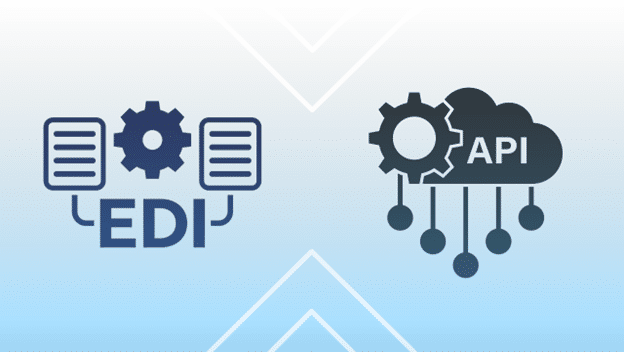Facing the choice of EDI versus API for your business data exchange? EDI offers the reliability of a structured, standardized format, while API proposes flexibility and real-time connectivity. Keep reading for an in-depth breakdown of how each approach can serve your business’s unique requirements. Whether it’s dependability or agility you’re after, our in-depth EDI vs API comparison is here to help guide you to the right choice. Additionally, combining EDI integrations with API can offer a comprehensive approach to B2B information exchange, automating data transmission and opening up business opportunities with new trading partners.
Key Takeaways
- EDI is a proven, standardized format for exchanging business documents, ideal for high-volume transactions, while API offers real-time data access and greater flexibility, but requires defining communication standards.
- APIs have grown in versatility, powering real-time, web-based interactions and are essential for modern services and applications, whereas EDI has been stable for over 50 years but could be less compatible with newer systems.
- Integrating EDI and API can provide the best of both worlds, offering real-time processing, scalability, and enhanced efficiency, but it requires careful selection of tools and management of integration complexities.
- When deciding between EDI vs API for your business data exchange, consider whether your priority is the reliability and standardization of EDI or the flexibility and real-time capabilities of API.
Demystifying EDI and APIs
In a world where businesses are like islands in a sea of data, EDI and API are vital ferry services, bringing people, processes, and technology together. They are the key to effective connection and communication in a business ecosystem riddled with a complex mix of legacy systems and cloud applications.
On one hand, there’s EDI, a tried-and-true method that facilitates the computer-to-computer exchange of EDI data and business documents in a standard electronic format. It’s like a trusty steamboat, reliable and robust.
On the other hand, we have application programming interfaces (APIs), the sleek speedboats of the data exchange world. These allow for the development of modern applications that connect and share data seamlessly, offering greater flexibility and customization options.
EDI replaces paper documents and manual processes in business transactions, automating the exchange of information between trading partners and eliminating the need for manual entry and paper-based communication.
Understanding Electronic Data Interchange
EDI is definitely the veteran protocol when it comes to data exchange. It has been evolving since the 1960s when businesses started swapping manual transaction processes for computation power. You can think of EDI as an interpreter that allows two systems to talk to each other by converting business documents, such as purchase orders and invoices, into a standard electronic format.
In the early days of EDI, it wasn’t as accessible due to the high cost and complexity of implementation. However, as technology advanced, EDI became more streamlined, allowing for broader adoption across industries. EDI’s early adopters spanned industries like automotive, retail, and manufacturing, and each had their own way of exchanging documents. To ensure consistent document exchange across varying internal software systems, EDI standards were created. The Transportation Data Coordinating Committee (TDCC) developed some of the first EDI standards way back in the 1970s, concentrating on the transportation sector.
Historically, EDI played a significant role in industries like automotive, retail, and supply chain processes, utilizing batch processing to exchange structured data. In contrast, APIs offer real-time interactions, enhancing the efficiency of B2B systems and trading partners.
With the emergence of ANSI’s ASC X12 standards in the 1980s, EDI matured and became a reliable tool for exchanging data. Over the years, this evolution has solidified EDI’s role as a critical component of global supply chains, ensuring consistent and efficient business document exchange.
Read more: What is EDI: Electronic Data Interchange Explained
Understanding Application Programming Interface
APIs, on the other hand, are the newer kids on the block. The concept of an API emerged in the 1950s to facilitate communication between computers, and has evolved from simple command-line interfaces to complex web services that enable extensive data interchange across the internet. APIs expanded to support Remote Procedure Calls (RPCs) in the 1980s, playing a crucial role in cross-platform compatibility and allowing developers to:
- Access libraries on remote computers
- Integrate different software systems
- Enable data sharing and collaboration
- Build scalable and modular applications
APIs serve a primary function in enabling real-time data exchange and integration between software systems, offering flexibility in connectivity and communication. They simplify the integration process by using a common language for different software applications, thereby enabling more efficient communication. And unlike EDI that works on batch processing, APIs enable real-time data retrieval and updates, which is essential for applications requiring immediate data synchronization.
Two prevalent API types are REST and SOAP, with REST being more commonly used for cloud-based applications due to its robustness and user-friendly services.
Quick guide:
REST (Representational State Transfer) APIs are designed around the use of standard HTTP methods to make calls between machines. They are favored for their simplicity, scalability, and efficiency in handling web services, making them ideal for cloud-based applications.
SOAP (Simple Object Access Protocol) APIs are protocol-based and rely on XML for their message format, ensuring high levels of security and standardized operations. They are commonly used in enterprise environments where rigorous messaging frameworks are required.
Comparing EDI and API: Key Differences
Having introduced EDI and API, it’s time to compare them directly. While EDI is a seasoned technology that has not seen significant changes for over 50 years, APIs have been growing in popularity as an alternative. But does that make API the better choice? Not necessarily.
EDI standards such as ANSI ASC X12, TRADACOMS, UN/EDIFACT, and ODETTE vary by industry and geography, which can complicate the implementation process. API, while potentially less costly and more straightforward than EDI, also requires more collaboration to reach communication standards. One significant cost advantage of API implementation is that it does not require ongoing maintenance or translation services, unlike EDI.
While EDI ensures data consistency, APIs offer flexibility and real-time data access, serving different business needs. However, APIs are susceptible to a wide range of internet-based security threats, including:
- Man-in-the-middle attacks
- CSRF attacks
- XSS attacks
- SQL injection
- DDoS attacks
Ultimately, the best choice between EDI and API hinges on specific business requirements, including aspects like implementation ease, compliance, security, and system compatibility.
Technology and Formats
When it comes to technology and formats, EDI is a more uniform protocol. It exchanges business documents in standard formats, providing universal compatibility. These standardized document formats ensure compatibility across various businesses and systems, making EDI an attractive option for large-scale operations.
APIs, on the other hand, offer more flexibility. They consist of protocols, data structures, and tools for software applications to communicate. Modern APIs often use JSON (JavaScript Object Notation) as a lightweight data-interchange format, making them particularly suitable for web and mobile applications due to its ease of use with JavaScript and other modern programming languages.
Protocols and Real-Time Capabilities
In terms of protocols and real-time capabilities, EDI employs structured communication protocols such as AS2 and SFTP, tailored for secure and dependable data transfer. However, its batch processing nature, where documents are accumulated and sent collectively, limits the ability for real-time data exchange.
Web service APIs complement EDI by providing real-time data exchange and easy integration with back-end business systems, especially in Cloud SaaS applications. They play a crucial role in a B2B integration strategy by offering real-time access to various B2B transactions.
APIs, in contrast, utilize web protocols like HTTP/HTTPS and adhere to standards such as REST, which enable and enhance real-time communication capabilities. This real-time nature supports immediate data exchanges, significantly benefiting scenarios that demand instant access, such as e-commerce and interactive services.
Scalability, Efficiency, and Cost
EDI systems generally involve higher initial costs associated with:
- hardware
- software
- training
- specialized developers for setup and maintenance
On the other hand, API implementation tends to be less costly with fewer expenses on ongoing maintenance and no need for translation services.
While EDI enhances efficiency and speed of business transactions and can reduce manual data entry and paper-based processes, its flexibility and scaling possibilities are limited when compared to APIs. APIs, on the other hand, provide superior scalability, allowing companies to grow and adapt their infrastructure to increasing data volumes and user demands more easily than EDI. But there are drawbacks to using APIs as well.
Pros and Cons of EDI and APIs
Let’s further explore the pros and cons of both EDI and API. In reality, businesses aren’t forced to exclusively choose between EDI or API, as these are often combined in practice. The optimal choice depends on specific business needs and factors such as:
- Ease of implementation
- Compliance
- Security
- System compatibility
APIs are gaining popularity as an alternative to EDI for trading partner communications within the supply chain.
EDI offers a standardized data exchange format that increases operational efficiency and improves partner relationships. However, using API for data exchange may incur lower costs than EDI, but can also introduce complexity in adding new trading partners and establishing standard communication protocols.
Advantages of EDI
EDI is like the dependable workhorse of data exchange technologies. It’s well-suited for high-volume data transfers, enabling the handling of mass data exchanges and large volumes of transactions efficiently. The structured and standardized format of EDI reduces errors and data mismatches, providing security and enhancing the integrity of large dataset transfers.
EDI’s widespread adoption across various industries has created a large network of trading partners already utilizing and supporting EDI transactions. Integrated EDI processes streamline operational workflows, improve customer service, and increase the speed and accuracy of data processing within a company’s existing systems. Furthermore, EDI provides improved visibility into supply chain operations and fosters enhanced collaboration, allowing businesses to better track, manage, and partner within their supply chains.
Disadvantages of EDI
On the downside, EDI systems typically have the following challenges:
- They require a more significant initial investment in terms of setup and maintenance, reflecting their robust and tested data exchange mechanisms.
- EDI relies on older, legacy systems which may not be as flexible as modern technologies.
- This can lead to integration challenges with newer systems, however a good EDI solution provider can assist you or even handle everything on your behalf.
The complexity of establishing and maintaining EDI connections due to various standards and formats can make EDI integration challenging. Adherence to specific EDI standards can pose a barrier to entry for new trading partners or present challenges when changes in standards occur.
Advantages of APIs
As we’ve mentioned, APIs are like the speedboats of data exchange technologies. They provide real-time access and flexibility. This can be crucial for mobile apps to connect with external services and databases, facilitating a diverse range of features for the user. Through real-time communication capabilities, APIs support crucial online services like payment gateways for web-based transactions.
APIs use flexible and easily comprehensible data formats like JSON or XML, simplifying integration with modern software systems for developers. API-first design methodologies are central to the construction of IoT devices and AI, underlining APIs’ role in establishing an interconnected data environment.
Additionally, APIs efficiently connect with partner and SaaS applications, enhancing the agility and innovative capacity within an organization. They are well-suited for handling real-time single requests for information, which is especially beneficial for API-enabled cloud applications involved in web-based transactions.
Disadvantages of APIs
APIs, however, are not without their drawbacks. They may not have as widespread adoption as EDI in certain industries, which can limit partner availability and integration opportunities. If your industry relies on EDI transactions for essential information transfer, then EDI is the right protocol for that use-case.
Combining EDI and APIs: A Unified Data Exchange Approach
Let’s consider the potential of merging EDI and API into a singular data exchange strategy. Integrating EDI and API streamlines data exchange processes, providing opportunities for:
- Automated data transmission
- Solidifying a business’s position in the market with various trading partners
- Enhancing data accuracy and consistency
- Ensuring reliable data across different customer touchpoints
- Reducing data entry errors through automated processes.
Both EDI and API are used to transmit data from one business partner to another. EDI is known for its reliability and compliance, while API offers real-time access and flexibility. Understanding the strengths and weaknesses of each method in terms of data transmission can help businesses choose the right approach for their needs.
Embracing a unified system capable of managing both EDI and API partners offers enhanced scalability and adaptability, allowing businesses and their business partners to:
- Swiftly adjust to operational demands
- Integrate new systems without major disruptions
- Streamline the integration process
- Improve overall business efficiency
Furthermore, the synergy of EDI and API contributes to cost reduction.
Improved Data Accuracy and Consistency
Integrating EDI and API promotes enhanced data validation processes, which ensure the accuracy of data before transmission or further processing. A unified EDI and API strategy minimizes data inconsistencies by establishing a central source of truth for data exchanges.
Hybrid EDI implementation decreases manual data entry, resulting in more accurate data and faster business operations, and enhances partner visibility through more efficient data transfers.
Enhanced Integration and Automation to Streamline Business Processes
APIs enable seamless EDI and API integration, allowing different software applications to connect and communicate more efficiently, leading to enhanced operational efficiency. Integrating EDI with APIs automates end-to-end data flows, minimizing the need for manual input and reducing error rates in data exchange.
Streamlined integration and automation processes through API deployment enable organizations to streamline business processes, achieve strategic value, leading to increased revenue and opportunities to expand into new markets.
Scalability and Flexibility
A unified EDI and API data exchange approach allows businesses to adapt to operational changes and integrate new systems rapidly, fostering an agile and responsive IT infrastructure. Adopting a hybrid data exchange strategy with EDI and API can support the expansion of businesses by allowing for the seamless addition of new sales channels or services.
A combined EDI and API environment enables companies to handle increasing data volumes and user demands without compromising on performance or reliability. Cloud-based integration solutions offer scalability by allowing companies to adjust their integration needs on demand, while the standardized format of EDI combined with the flexibility of API caters to different trading partner and application requirements. The synergy between EDI and API technologies supports both traditional B2B exchanges and modern, dynamic business needs, providing a versatile approach to data integration.
Implementing a Hybrid EDI and API Solution
Convinced that a hybrid EDI and API solution is the optimal choice? Here’s where to begin. Implementing a hybrid solution should begin with an assessment of enterprise needs, considering system diversity among partners and the requirement for supply chain agility. Hybrid EDI can bridge different data sources, systems, or applications, fostering a seamless flow of information among companies with varying hosting infrastructures.
Hybrid EDI solutions encompass:
- Advanced translation tools for ensuring format compatibility
- Orchestration functionalities for directing specific data flows
- Monitoring tools for the continuous correct operation of integrated systems.
Choosing the Right Tools and Platforms
Selecting tools and platforms for hybrid EDI and API solutions must account for their ability to integrate multiple systems, including varied domains and endpoints such as on-premise systems, cloud applications, and IoT devices.
The nature of use, reflecting the operational mode and system architecture, is a critical consideration when evaluating EDI tools and platforms for business integration.
Overcoming Integration Challenges with Trading Partners
Steering through the complexities of integration can be daunting. Transactional APIs enable legacy EDI systems to link with modern REST APIs, safeguarding investments while updating business operations. Cross-training staff on legacy EDI and modern APIs leads to a smoother transition and implementation of hybrid EDI and API integration solutions.
Investing in platforms capable of integrating a broad spectrum of networks and devices is crucial for handling integration complexities effectively. Therefore, choosing EDI solutions that support all standards and offer flexible operation modes can greatly alleviate integration challenges. Moreover, EDI software with a solid support system, including round-the-clock assistance through various channels, is pivotal in overcoming barriers to integration.
Transform Your Data Exchange with Comparatio
In the evolving landscape of EDI and API, choosing the right technology partner is crucial. Comparatio offers customized EDI and API integration solutions tailored to the unique needs of industries like Distribution, Manufacturing, 3PL, Retail, Ecommerce, and more. Our solutions offer the reliability of EDI for traditional data exchange and the flexibility of APIs for modern, real-time connectivity. We cater to diverse business needs with the option to utilize them independently or in tandem for enhanced integration and operational excellence.
Why Comparatio?
- Customized Solutions: Tailored EDI and API solutions that fit your specific industry requirements.
- Seamless Integration: Easy integration with existing systems for improved efficiency and data accuracy.
- Industry Expertise: Decades of experience across various sectors, ensuring solutions that drive your business forward.
Leverage Comparatio’s innovative solutions to streamline your data exchange processes, enhance operational efficiency, and gain a competitive edge. Discover how.
Summary
Choosing between EDI and API hinges on your business’s need for reliability and standardization versus flexibility and real-time connectivity. While EDI excels in structured data exchange for high-volume transactions, API offers immediacy and adaptability for web-based services. However, the modern business landscape often demands a blend of both technologies. Integrating EDI and API allows businesses to leverage the strengths of each, ensuring efficiency, scalability, and real-time processing to meet diverse operational needs.
Your Partner in Data Exchange: Comparatio
At Comparatio, we understand the complexities of choosing between EDI and API for your business. That’s why we offer customized solutions tailored to your specific needs, ensuring that whether you require the robust reliability of EDI, the flexible connectivity of API, or a combination of both, we have the right solution for you. Our expertise spans various industries, enabling us to provide seamless integration, operational excellence, and the strategic advantage your business needs to succeed.
Ready to explore how Comparatio can transform your data exchange strategy? Discover our solutions and take the first step towards a more connected and efficient future.
Frequently Asked Questions
What’s the difference between EDI and API?
The main difference between EDI and API is that EDI is a system-to-system connection, while API is a web-based protocol that enables various systems to communicate with each other effectively. Therefore, API allows for faster data flow between systems.
What are the benefits of EDI + API?
The combination of EDI and API provides logistics companies with faster communication and automation of data transmission between systems. This helps businesses gain a stronger market presence and opens doors to new trading partners.
Is EDI outdated?
No, EDI is not outdated. It has continually evolved and is now more relevant and cost-effective than ever thanks to cloud technology.
What is EDI and API?
EDI, or Electronic Data Interchange, enables computer-to-computer exchange of business documents in a standard electronic format, while API, or Application Programming Interface, allows different software applications to connect and share data seamlessly. Both are essential technologies for efficient data exchange and integration.






